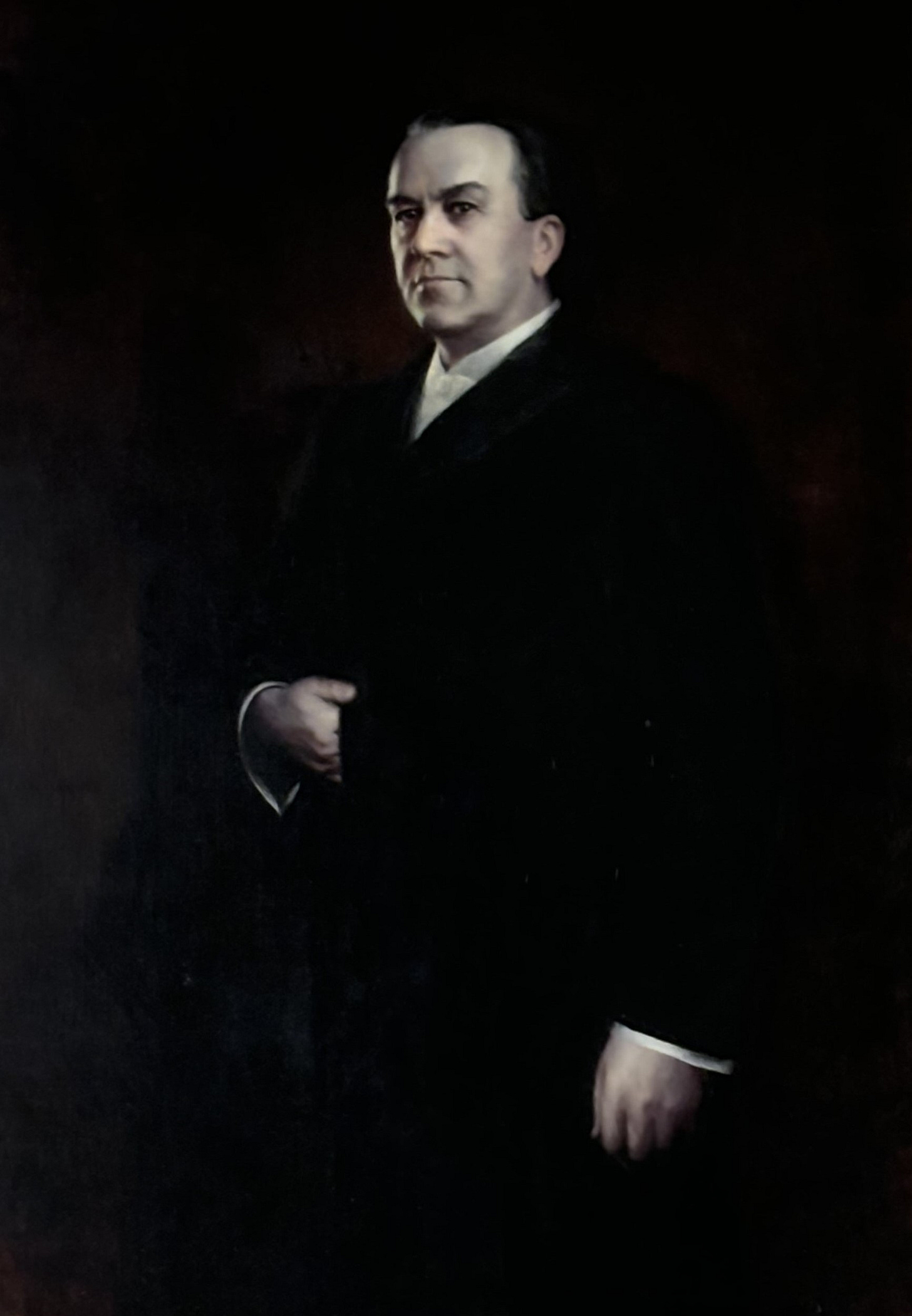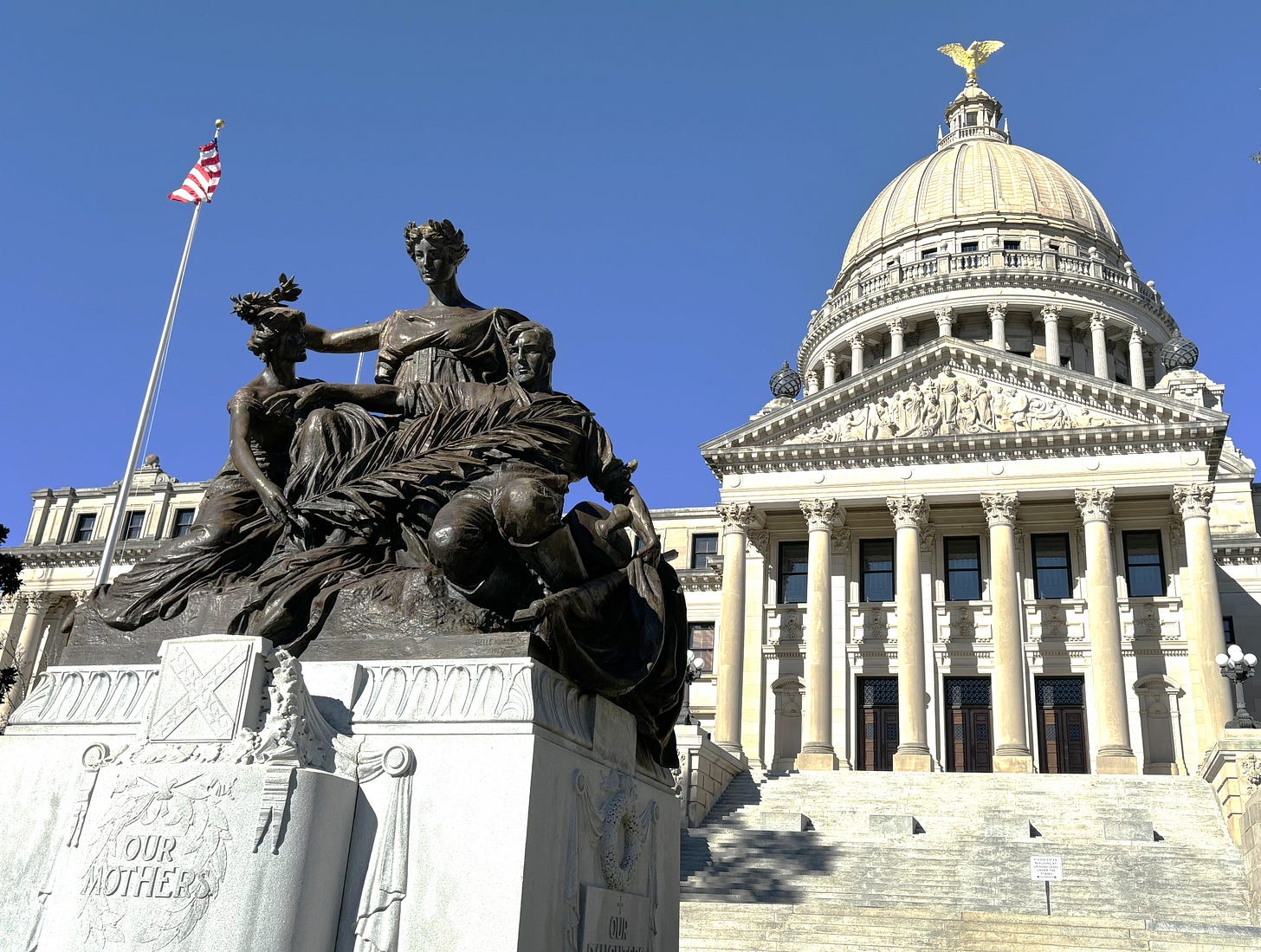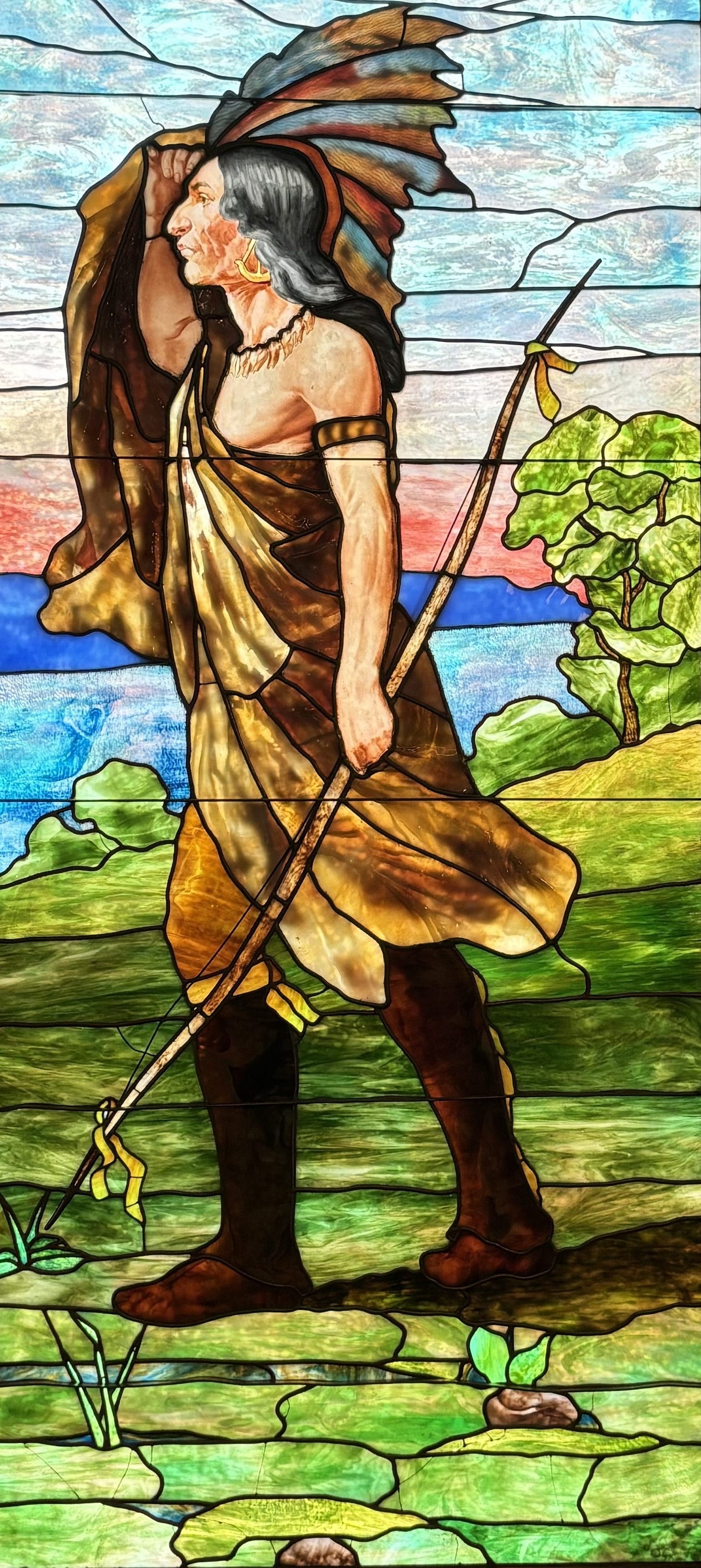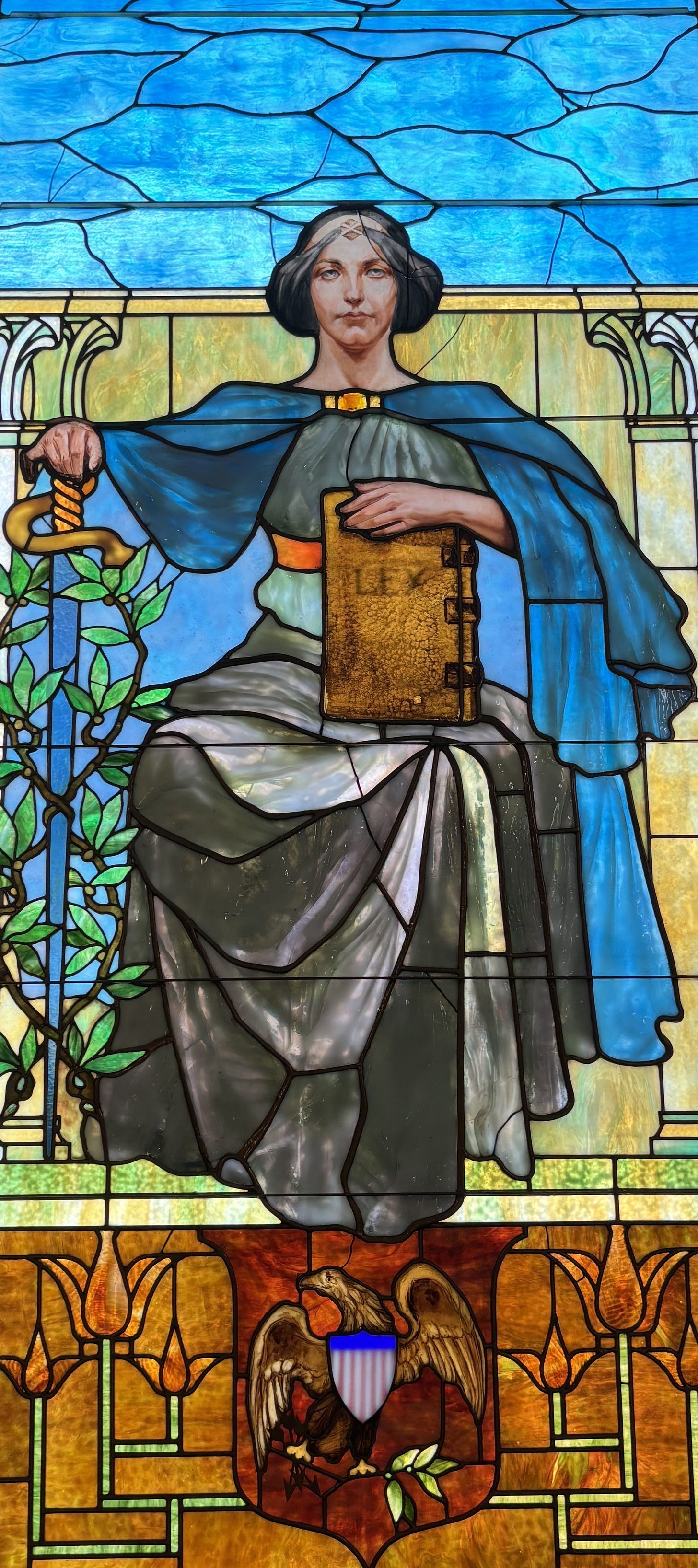Stained Glass
On a tour of Mississippi's State Capitol, writer and ecologist Christopher Norment considers "the complicated nexus between...what we choose to remember, and what we choose to forget."
“You think too much”—or so I’ve been told by friends, family, and at least one former partner. My tendency to “think too much”—a product of innate inclination and my scientific training—was partly what I was thinking about as I approached Mississippi’s State Capitol a few months back. I was there to consider the complicated nexus between the Capitol’s imposing Beaux Arts space, Mississippi’s history, what we choose to remember, and what we choose to forget. And for whatever reason, the soundtrack for my visit featured a weird combination of W. H. Auden and Modest Mouse. The rabbit-hole beckoned.
After passing through the metal detector at the public entrance, I climbed a marble staircase to the rotunda, its vaulted space a gathering of scagliola columns and the major classical orders, from Tuscan to Composite; great soaring arches; and black cast iron balustrades. Above me were four relief sculptures of blindfolded Lady Justice, the Mississippi and U.S. flags, and high in the dome, four painted WPA-era medallions depicting imaginary scenes from the state’s history. The rotunda hosted a quiet grandeur and solemnity, a measured order produced by the Beaux Arts architectural principles that were all the rage in fin de siècle United States: “…a pure renaissance classic of a dignity and elegance of proportion which will fittingly express the power, honor, and stability of the State.” Or so wrote the architect Theodore Link in 1903, the year that the new Mississippi Capitol was completed.
From the second floor I ascended the grand staircase to a landing, where three leaded stained glass windows shone, each framed in mahogany-colored wood, roughly ten feet high and four feet wide, arched at the top and flat across the bottom. According to “A Guide to the Architecture of the Mississippi State Capitol,” they represented the Native American, Mother Mississippi, and the Pioneer. Each window was bathed in a luminous palette of blues, greens, and browns: intimations of Tiffany Glass, though crafted by the Louis Millett Company of Chicago.

The Native American was a warrior, dressed in moccasins and leather breeches, with a robe thrown across one shoulder. His black hair was long, and he gripped a bow in his left hand. Unlike the Pioneer, he wore decorations: a large gold earring, necklace, and leather band on his left bicep. He looked more archetypal than representative of one of Mississippi’s Native American nations, circa 1800. According to the 19th century sketches that I’d seen, he was neither Chickasaw nor Choctaw. Chickasaw men traditionally shaved their heads, while the warrior was dressed differently than the men sketched around 1830 by the French naturalist and artist Charles Alexandre Lesueur. Whatever his identity, the window-warrior was moving across an open green field, past several trees in the middle distance; beyond him was a large lake and dark blue mountain range. The scene was more reminiscent of New York’s Finger Lakes region—near where I lived for thirty years—than Mississippi. No matter, though—the window was meant to be iconic, not photographic.
Mother Mississippi looked out from the middle window, but unlike the Native American and Pioneer, she gazed directly at me. Her eyes trended colorless but carried a hint of the palest blue. Her hair was grayish-black; she wore gray robes and a cloak of cerulean blue. Her right hand rested on the golden hilt of a long sword, while her left hand grasped a tan-colored book titled “Lex,” Latin for law. Her bearing was determined, noble, and slightly severe: shades of Tolkien or C. S. Lewis, perhaps, but instead of Middle-earth or Narnia she was of the United States, for Mother Mississippi sat perched above an American eagle shield. And she took her responsibilities seriously.
The Pioneer, like Mother Mississippi, was white, although his eyes were darker blue. He wore knee-high boots, brown pants, a dark brown hat, and a dark blue shirt speckled with flecks of pale blue light. His hair and beard were light brown—the hair short, beard longer but well-kept. At his back, there was a Finger Lakes-type landscape like the one traversed by the Native American, but the Pioneer was still. His left hand gripped an axe; its head rested against a tree stump, for our yeoman farmer had cleared the forest that once covered his land. He was not of the wealthy planter class, but he was resolute, and he was there to stay.
I stood on the landing, thinking too much. Nobody passed me; the legislature was in recess and the governor was AWOL, perhaps because (as he once said) “It’s a great day not to be in Jackson.” My thoughts eddied around the three stained glass windows and the Capitol, symbols and stories, and historical memory. To make sense of it all—particularly the windows— required a computer, data, and the Mississippi Department of Archives and History. In the following weeks I found what I needed, by way of channeling Sgt. Joe Friday of the 1950s television cop show, Dragnet: “Just the facts, ma’am.” (And “sir.”)
In any public representation of history, what’s left out is as important as what’s presented—and what we ignore helps perpetuate the misunderstandings and tragedies of our past.
Regarding the Native American warrior, and his place in what became the state of Mississippi in 1817:
In 1830 the Mississippi Choctaw population was about 19,550. After their forced removal between 1831 and 1833, only 5,000 Choctaw remained in Mississippi. About 2,500 died along The Trail of Tears to Oklahoma. The forced removals followed the 1830 Treaty of Dancing Rabbit Creek, which ceded almost 11 million acres of Choctaw land to the federal government, much of which passed into white private ownership once the Choctaw were evicted from their ancestral lands.
Regarding Mother Mississippi’s “Lex” and its relationship to the fair and proper governing of all Mississippians, circa 1900:
In 1890 Mississippi rewrote its constitution, using a poll tax and literacy test to disenfranchise Black voters. Consequently, the percentage of registered eligible Black voters in the state decreased from 67% in 1867 to less than 6% in 1892.
James K. Vardaman was the first governor of Mississippi to be inaugurated at the new Capitol. In his 1904 inaugural speech, Vardaman said: “. . .the North expressed its hatred of the white people of the South in the amendments to the Federal constitution, which invested the negro with all the rights and privileges of citizenship.” In 1907 Governor Vardaman also said, “If it is necessary every Negro in the state will be lynched; it will be done to maintain white supremacy.”
According to an exhibit at the Mississippi Civil Rights Museum, in the two decades spanning construction of the Capitol (1890-1910) there were 295 documented lynchings in Mississippi, although more likely occurred. Among known lynching victims, 91% were Black, 6% were white, and < 1% were Native Americans; about 2% were of unknown race.

Regarding the white Pioneer and his primacy in clearing land and developing Mississippi’s agricultural economy during the 1800s and early 1900s:
Although the enslaved population in Mississippi varied greatly across its counties, much of the state’s land was cleared and prepared for agriculture by enslaved people.
In 1908, Alfred Stone, who owned a plantation near Greenville and held racial views typical for his time, wrote: “The railroad rights of way through its forests have been cut out by the Negro, and every mile of track laid by his hands. These forest lands have been converted by him into fertile fields, and their subsequent cultivation has called for his constant service. The levees upon which the Delta depends for protection from floods have been erected mainly by the Negro, and the daily labour in field and town, in planting and building, in operating gins and compresses and oil mills, in moving trains, in handling the great staple of the country—all, in fact, that makes the life behind these earthen ramparts—is but the Negro’s daily toil.”
Cotton production in Mississippi, which required land cleared mostly by enslaved people—who also grew and picked the crop—rose from 0 pounds in 1800 to 535 million pounds in 1859. Cotton was the economic driver for Mississippi from the mid-1800s through the early 1900s, when the Capitol was built. In 1860, Mississippi produced 20% of the world’s cotton supply.
Regarding the three stained glass windows, taken as a whole, and what they suggest about the demographics (and history) of Mississippi:
According to the 1900 Census, 41% of Mississippi’s population was white (641,200) and 58.5% (907,630) was Black.
Given the information presented above, at the very least the three stained glass windows represent a trifecta of unintended irony. Of course, other, more plausible interpretations exist.
I was not picking on Mississippi—just trying to understand the three windows and their message. I could ask similar questions about what’s missing from historically-framed art in Buffalo, Tucson, Chicago, Munich, Beijing, or Santiago, for when it comes to history (and so much else) people everywhere yearn to see what they already believe, rather than the world as it was and is.
A month after my first visit to the Capitol, I returned for a scheduled tour. I was the only taker, and when we came to the three stained glass windows, I asked my friendly guide, who happened to be white, if she would mind fielding a difficult question about their historical context, one that I’d been struggling with. It wasn’t a particularly good lead-in, but I sensed that my question would not go over well. I then asked about the absence of Blacks in the stained glass windows, even though in 1900 they comprised over 60% of the state’s population, while their labor created much of Mississippi’s wealth—and undoubtedly helped build the Capitol.
Even though I’d left the more potentially incendiary questions alone—say concerning lynchings or the disenfranchisement of Black voters—my tour guide visibly tensed. It was as though I’d poked her with a needle—which I supposed was true, even if the needle was only metaphorical.
“Where are you from?” she asked (smiling), the subtext being (I believe) that my question would not have come from a native (white?) Mississippian.
I replied that I was from Mississippi—I owned a house in Jackson, had a Mississippi driver’s license, etc. I knew that this wasn’t what she meant, so I fessed up: I was born and raised in California and have lived all over the country. I added that I was not picking on Mississippi—just trying to understand the three windows and their message. I could ask similar questions about what’s missing from historically-framed art in Buffalo, Tucson, Chicago, Munich, Beijing, or Santiago, for when it comes to history (and so much else) people everywhere yearn to see what they already believe, rather than the world as it was and is.
My guide then said that “Here in Mississippi we love our history.” I wanted no argument, and so did not counter with my belief that although the three windows embodied a narrow history involving the Louis Millett Company of Chicago and their 1903 installation (and maybe that’s something most Mississippians could love)—they also embraced another, more profound history related to the stories that they told, and did not tell.
At the end of our conversation about the windows, my guide added, “In Mississippi, we all get along now.” (I was silent again, although I wondered if the inherent social politeness possessed by so many Mississippians equates to everyone “get[ting] along now.”)
I didn’t want to finish the tour on a divisive note, so I asked to see the stained glass in the legislative chambers, although it was purely decorative and carried little historical weight. Fifteen minutes later, and I was gone from the Capitol. And what weirdly came to mind as I walked back to my car—and this may have been a bit unfair—were the “Heritage Not Hate” coffee cups that I once saw in the gift shop at the Old Courthouse Museum in Vicksburg, emblazoned with the Confederate battle flag. It’s a symbol that evokes a visceral reaction in most everyone, no matter what their perspective, as the wrenching trauma of the Civil War and all that followed reverberates across the years. “The past,” wrote Faulkner, “is never dead. It’s not even past.”
It's a difficult issue: how to curate history. Should each stained glass window, each portrait in the Capitol’s “Hall of Governors” (James K. Vardaman, we can see you now!), and each “historical” medallion in the rotunda—as well as the Monument to the Women of the Confederacy, which stands below the south entrance to the Capitol—carry a modern-day disclaimer? And if so, whose ideology should frame the disclaimer, ideology being notoriously fickle and distortional? (Cue “Missed the Boat,” by Modest Mouse: “Our ideas held no water, but we used them like a dam.”) Or should the Capitol’s art float free from our judgement, unburdened by contemporary notions of historical accuracy, fairness, and social/political power? I don’t know, although simply admiring the Native American, Mother Mississippi, and Pioneer as art fails to grant them sufficient context. Beautiful as they are, looking at those windows without acknowledging something of Mississippi’s (and our nation’s) history and trauma is a bit like hearing the punchline to a joke without first understanding its setup. Take for example: “Someone who tells you how they’re really feeling when you ask them how they’re doing.” Not funny, until you know the setup, which provides the joke’s context: “What’s the definition of a pest?”
Another way of thinking about the Capitol’s stained glass windows—along with the building itself—involves the notion of musical rests, which are as critical as the notes themselves to any musical work’s structure and expression. In music, what’s missing is as important as what’s present, whether we’re talking “Purple Haze” or Beethoven’s Ninth Symphony. Likewise, in any public representation of history, what’s left out is as important as what’s presented—and what we ignore helps perpetuate the misunderstandings and tragedies of our past.
Beautiful as they are, looking at those windows without acknowledging something of Mississippi’s (and our nation’s) history and trauma is a bit like hearing the punchline to a joke without first understanding its setup.
The three stained glass windows are a lovely and mesmerizing compliment to the Beaux Arts architectural style that graces Mississippi’s Capitol. They’ve also forced me to consider how historical narrative affects our present-day world, and so whenever I visit the Capitol, I return to the head of its grand staircase, where the Native American, Mother Mississippi, and Pioneer gaze at me across a temporal and cultural gulf of 120 years. And as I look up at the three stained glass figures, I sometimes hear the faint whisper of lines from “Musee des Beaux Arts,” by W. H. Auden: “how everything turns away / Quite leisurely from the disaster.” In Auden’s poem, the disaster is Icarus plummeting into the Aegean Sea, while here in Mississippi the disaster is the ache and anger that blossoms in the flowering of our forgetting.











Lauren and Christopher - Hey, Elizabeth Robinson glass girl here. Loved reading this article and have a great visual of the visit with the Docent at the State Capitol. I am currently project managing (PRGS) the restoration of the stained glass skylight in the House of Reps, State Capitol. This large project has been undertaken by Pearl River Glass Studio. Andy and his team also restored the three windows that Christopher speaks about in this article (2014). Even though this current skylight is decorative and not figurative, it would be great to have both of you come to studio to see the project in process. And, since PRGS does a considerable amount of the figurative stained glass work in the state of MS (predominantly church windows), we could talk about what Andy has seen in his (as of this year) 50 years of business in the art glass world. Drop me a note and let’s set up a visit, if of interest: elizabeth@spirithouseglass.com
I asked this same question to our Capitol architectural expert when I was in my Leadership Greater Jackson class in 2009. There is no good answer to this question except racism!